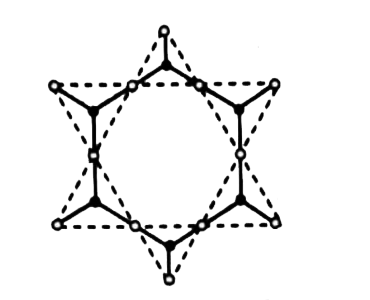Consider following four compounds:
(i) CxOy
(ii) CxOy+1
(iii) Cx+2Oy+1 and (iv) Cx+11Oy+8,
if "x=y=1", then calculate the vlaue of |p-q|, where p and q are total number of sp2 and hybridized carbon atoms respectively in given four compounds.
The correct Answer is:7
To solve the problem, we need to analyze each of the four compounds given the values x=1 and y=1. We will determine the number of sp² and sp hybridized carbon atoms in each compound and then calculate |p−q|, where p is the total number of sp² hybridized carbon atoms and q is the total number of sp hybridized carbon atoms.
Step 1: Analyze each compound
1. Compound (i): CxOy
- Substituting x=1 and y=1, we have CO.
- The structure of CO can be represented as C≡O (a triple bond between carbon and oxygen).
- Hybridization:
- The carbon in CO is sp hybridized (due to the triple bond).
- Count:
- sp² carbon = 0
- sp carbon = 1
2. Compound (ii): CxOy+1
- Substituting x=1 and y=1, we have CO2.
- The structure of CO2 is O=C=O (a double bond between carbon and each oxygen).
- Hybridization:
- The carbon in CO2 is sp² hybridized.
- Count:
- sp² carbon = 1
- sp carbon = 0
3. Compound (iii): Cx+2Oy+1
- Substituting x=1 and y=1, we have C3O2.
- The structure can be represented as O=C=C=C=O (with double bonds between the carbon atoms and double bonds to oxygen).
- Hybridization:
- Each of the three carbon atoms is sp² hybridized.
- Count:
- sp² carbon = 3
- sp carbon = 0
4. Compound (iv): Cx+11Oy+8
- Substituting x=1 and y=1, we have C12O9.
- The structure can be complex, but it can be represented as a chain of carbon atoms with alternating single and double bonds to oxygen.
- Hybridization:
- The carbon atoms can be arranged such that 12 of them are sp² hybridized due to the presence of double bonds.
- Count:
- sp² carbon = 12
- sp carbon = 0
Step 2: Total counts of sp² and sp hybridized carbons
Now we will sum up the counts from each compound:
- Total sp² carbon (p):
- From (i): 0
- From (ii): 1
- From (iii): 3
- From (iv): 12
- Total p=0+1+3+12=16
- Total sp carbon (q):
- From (i): 1
- From (ii): 0
- From (iii): 0
- From (iv): 0
- Total q=1+0+0+0=1
Step 3: Calculate |p−q|
Now we can calculate |p−q|:
|p−q|=|16−1|=|15|=15
Final Answer
The final answer is 15.
- Substituting x=1 and y=1, we have CO.
- The structure of CO can be represented as C≡O (a triple bond between carbon and oxygen).
- Hybridization:
- The carbon in CO is sp hybridized (due to the triple bond).
- Count:
- sp² carbon = 0
- sp carbon = 1
- Substituting x=1 and y=1, we have CO2.
- The structure of CO2 is O=C=O (a double bond between carbon and each oxygen).
- Hybridization:
- The carbon in CO2 is sp² hybridized.
- Count:
- sp² carbon = 1
- sp carbon = 0
- Substituting x=1 and y=1, we have C3O2.
- The structure can be represented as O=C=C=C=O (with double bonds between the carbon atoms and double bonds to oxygen).
- Hybridization:
- Each of the three carbon atoms is sp² hybridized.
- Count:
- sp² carbon = 3
- sp carbon = 0
- Substituting x=1 and y=1, we have C12O9.
- The structure can be complex, but it can be represented as a chain of carbon atoms with alternating single and double bonds to oxygen.
- Hybridization:
- The carbon atoms can be arranged such that 12 of them are sp² hybridized due to the presence of double bonds.
- Count:
- sp² carbon = 12
- sp carbon = 0
- From (i): 0
- From (ii): 1
- From (iii): 3
- From (iv): 12
- Total p=0+1+3+12=16
- From (i): 1
- From (ii): 0
- From (iii): 0
- From (iv): 0
- Total q=1+0+0+0=1
Topper's Solved these Questions
- p-BLOCK ELEMENTSBOOK - VK JAISWAL ENGLISHCHAPTER - p-BLOCK ELEMENTSEXERCISE - ASSERTION REASON TYPE QUESTIONS
24 Videos
- METALLURGYBOOK - VK JAISWAL ENGLISHCHAPTER - METALLURGYEXERCISE - ASSERTION-REASON TYPE QUESTIONS
29 Videos
- PERIODIC PROPERTIESBOOK - VK JAISWAL ENGLISHCHAPTER - PERIODIC PROPERTIESEXERCISE - MATCH THE COLUMN
11 Videos
Similar Questions
Consider the following silicates
(a) BaTi(Si2O9)
(b) ZnCa2Si2O7
Then calculate X+Y, where X and Y are total number of monovalent and divalent oxygen atoms in both silicates respectively.
View SolutionConsider following compounds,
(i) H3X−HCS (ii)H3Y−NCS (iii)(H3Y)2O (iv)(H2X)2O
The incorrect statement regarding given compounds is :
View Solution
Knowledge Check
An organic compound C6H12(X) on reduction gives C6H14(Y). X on ozonolysis gives two aldehydes C2H4O(I)andC4H8O(II). Identify the compounds X, Y and aldehydes (I) and (II).
AX=CH3CH=CHCH2CH2CH3,Y=CH3(CH2)4CH3,(I)=CH3CHO,(II)=CH3(CH2)2CHOBX=CH3CH2CH=CHCH2CH3,Y=CH3(CH2)4CH3,(I)=CH3CHO,(II)=CH3CHOCX=CH3CH2CH2CH=CH2,Y=CH3(CH2)4CH3,(I)=HCHO,(II)=CH3(CH2)2CHODX=CH3(CH2)3CH3,(I)=CH3CHO,(II)=CH3CH2CHO
Consider the following silicates
(a) BaTi(Si3O9)
(b) ZnCa2Si2O7
Then calculate X+Y, where X and Y are total number of monovalent and divalent oxygen atoms in both silicates respectively.
View SolutionFind the product. (i) (5−2x)(3+x) (ii) (x+7y)(7x−y) (iii) (a2+b)(a+b2) (iv) (p2−q2)(2p+q)
View SolutionTotal number of covalent bonds in C3O2 is x and y is the number of sp - hybridised atom. Find the sum of x+y?
View SolutionConsider the following reaction
xMnO−4+C2O2−4+zH+→xMn2++2yCO2+z2H2O
The value of x, y and z in the reaction are respectively
View SolutionCalculate vlaue of |x+y−z| for the followng sillicate [SixOy+z]z− anion.

View SolutionIf a,b,c are in G.P. and x,y are the arithmetic means of a,bandb,c respectively, then prove that ax+cy=2and1x+1y=2b
View SolutionFind the point of intersection of the following pair of lines :
(i)9x−10y=12 and 2x−5=0
(ii)y=m1x+c1 and y=m2x+c2
(iii)x+y=8 and x−y=2
View Solution
